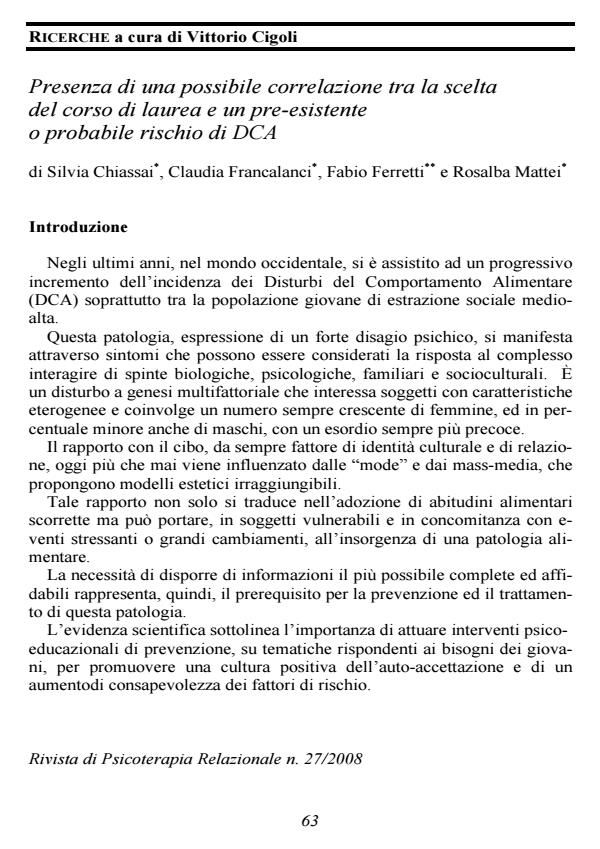Presenza di una possibile correlazione tra la scelta del corso di laurea e un pre-esistente o probabile rischio di DCA
Titolo Rivista RIVISTA DI PSICOTERAPIA RELAZIONALE
Autori/Curatori Silvia Chiassai, Claudia Francalanci, Fabio Ferretti, Rosalba Mattei
Anno di pubblicazione 2009 Fascicolo 2008/27 Lingua Italiano
Numero pagine 15 P. 63-77 Dimensione file 410 KB
DOI 10.3280/PR2008-027004
Il DOI è il codice a barre della proprietà intellettuale: per saperne di più
clicca qui
Qui sotto puoi vedere in anteprima la prima pagina di questo articolo.
Se questo articolo ti interessa, lo puoi acquistare (e scaricare in formato pdf) seguendo le facili indicazioni per acquistare il download credit. Acquista Download Credits per scaricare questo Articolo in formato PDF

FrancoAngeli è membro della Publishers International Linking Association, Inc (PILA)associazione indipendente e non profit per facilitare (attraverso i servizi tecnologici implementati da CrossRef.org) l’accesso degli studiosi ai contenuti digitali nelle pubblicazioni professionali e scientifiche
Presenza di una possibile correlazione tra la scelta del corso di laurea e un pre-esistente o probabile rischio di DCA - In the last years, in the occidental world, was developed an increase of the incidence in behavioural eating disorders, mostly by young people with a middle-high social status. There are many studies based on the nutritional habitudes of the adolescent, but we know less things about an eventually correlation between the eating disorder and the decision to follow an particular university course. Our purpose is to extend the pilot study made in the academic year 2005/2006 based on the questionnaire EDI-2 completed by the students that follows the University for Nutrition (I-II-III year of study), Obstetrician, Dental Hygienists, Sanitary Assistant, to valuate if the selection of the courses could be influenced by an pre-existent attitude more or less pathologic towards the food. The study was represented during the academic year 2006/2007, with the new students from the same courses. The considerable extension of the sample has permitted to obtain significant statistical results. The study is based on the test EDI-2 completed by the students between 16 and 49 years: 224 students, 187 females and 37 males (middle age 22,08 ds 4,72) The test EDI-2 (Eating disorder inventory-2) is the first and probably the most utilized method for individualizing the nutritional disorders, which can be utilized up the age of 11. The test are composed of 91 items, the first 64 represent the 8 primary scores while the last 27 represent the 3 additionals scores. The analysis of the dates shows that the nutritionists presents significant high scores in many scales. They have in particular important problems in the scale of bulimia compared with the other students. Comparing the scores M vs F, shows that sex can be an element which can influence the probability to be on risk or to present a behavioural eating disorder. Particular, the females shows high scores compared to the males on the scale Drive for thinnes (F=6,12; M=1,11). In the entire sample of study, the percents of female on risk is higher compared to the males, with higher values mostly in the scale Drive for thinnes (P<0.000; FM=5,7 vs MM=2,5), and in Body Dissatisfaction (P<0.000; FM=9,8 vs MM=5,1). Based on the results, it can be supposed that the choice of the course in nutrition is, for many students, conditioned by the pre-existent problematic rapport with the food. In particular it seems a higher probability among students following an Academic Nutrition course to have some bulimic problems, with a higher risk in the female group. Key words: behavioural eating disorders, mental anorexia, mental bulimia, binge eating disorders, university course, Eating Disorder Inventory-2.;
Silvia Chiassai, Claudia Francalanci, Fabio Ferretti, Rosalba Mattei, Presenza di una possibile correlazione tra la scelta del corso di laurea e un pre-esistente o probabile rischio di DCA in "RIVISTA DI PSICOTERAPIA RELAZIONALE " 27/2008, pp 63-77, DOI: 10.3280/PR2008-027004